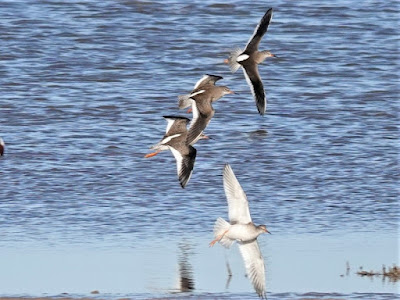I started at the rather unlikely location of a small marine lake behind the Morrison's shopping centre at New Brighton. A pontoon is used as a high-tide roost with the specialty being the small number of Purple Sandpipers. There are five here on the foreground platform along with a single, much paler Dunlin. The serried ranks behind are mainly Redshanks with four Turnstones visible.
Here are the five Purple Sandpipers again with two Dunlin. The sandpipers feed at low-tide on seaweed-covered rocks, usually on the seaward side where they can be hard to spot and difficult to access. They breed in the high Arctic. I saw some breeding in Alaska and they do indeed acquire a purple gloss to their plumage though we never see this in the UK.
Two Purple Sandpipers are the dumpy, orange-legged birds in the foreground. Two pale-looking Dunlin and a much larger Redshank with them.
Zoomed in as much as I could on these two.
Six (and a bit) Dunlin in front of a Purple Sandpiper 'just checking' with an eye open, ahead of a trio of Turnstone ahead of a mass of Redshank.
A view of the main pontoon with Dunlin in front of Turnstones and then Redshanks.
It is probably quite warm and cosy inside the group.
Always room for one more!
There were several Cormorants fishing in the lake. Here is an adult growing its breeding-condition head-plumes.
And here with the crest visible, also only present during the breeding season. You would not want to mess with that bill.
Meanwhile this Cormorant had caught a fish and decided that the easiest way to handle(?) it was to bring it on to the pontoon.
It took some rearrangement to get this flat fish lined up to provide it with a substantial meal.
Ever an opportunist: a Herring Gull stays close by for a chance to nab the fish.
An adult Lesser Black-backed Gull was watching proceedings. Still with winter head-streaking.
Close-by was this handsome adult Herring Gull (despite the black in the bill).
Using the car as a hide I was able to get this close-up and show the winter head-streaking. It does look rather fierce.
"Who me?"
Then it was on to Hoylake where some times thousands of birds can be seen. I timed an arrival just about high tide when the birds were closest. Later in the month the Spring tides will be higher still and the birds likely even closer. Here gulls in the foreground are ahead of hundreds of waders. Only the black-and white Oystercatchers can be identified. The rest are mainly Dunlin with numbers of Knot, Grey Plover, Redshank with a few Curlew.
Something spooked them and up they all go. The local expert estimated there were 17,500 Dunlin (not all visible here!).
It all looks chaotic but note that the birds are all 'lined up' flying parallel to each other.
Quite a spectacle.
And here the mass is circling with those in the front showing their backs and the others their bellies.
Two here.
One close-in. Mud is not a typical habitat for this species. Their name gives their preferred feeding method, flicking small stones with their rather stout and stubby bill to feast on insects hiding underneath.
The wind was blowing its skirt!
This one was really close!
And two on the mud feeding.
This one showing its slim bill. The barring on the flanks and tail indicates this bird is moulting in to breeding plumage.
The Oystercatchers mostly stayed well away from the shoreline. I did manage to photograph these two.
It was not quite all waders. The Dee Estuary holds many thousand Shelduck when they are moulting in Autumn. Here are three filtering the water for food. Most of them are further inside the estuary though some have already left for breeding areas.
(Ed Wilson)
































